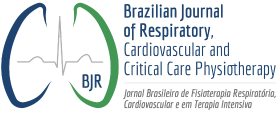Modelo computacional de hiperinsuflação em pulmões com padrão obstrutivo ao fluxo aéreo
Computational model of hyperinflation in lungs with airflow obstruction pattern
Kelser de Souza Kock, Estevan Grosch Tavares, Daniela Ota Hisayasu Suzuki
Resumo
Introdução: A modelagem matemática é uma técnica que utiliza pressupostos teóricos e simulação computacional para compreensão e predição de dados experimentais. Objetivo: modelar matematicamente, por meio de simulação computacional, o mecanismo de hiperinsuflação durante a respiração espontânea em pulmões com padrão obstrutivo ao fluxo aéreo através de variáveis relacionadas à mecânica respiratória: complacência e resistência do sistema respiratório. Métodos: Para construção do modelo foi realizado cálculo numérico através da equação do movimento, considerando-se que na fase inspiratória a pressão varia senoidalmente e na fase expiratória a pressão é nula. O ciclo respiratório foi simulado durante 20 segundos em 4 casos: eupneia e taquipneia em pulmão hígido, eupneia e taquipneia em pulmão com padrão obstrutivo ao fluxo aéreo. Resultados: os valores de volume expiratório final aproximaram-se de 0,0006, 0,0181, 0,0562 e 0,2145 litros, para os 4 casos, respectivamente, conforme simulação. Conclusão: A implementação deste modelo computacional demonstrou que variáveis de mecânica respiratória podem ser utilizadas para predizer o aprisionamento aéreo.
Palavras-chave
Abstract
Introduction: Mathematical modelling is a technique that uses theoretical assumptions and computer simulation to understand and predict experimental data. Objective: The objective of this study was to model mathematically, through computer simulation, the hyperinflation mechanism during spontaneous breathing in lungs with an airway obstruction pattern, using the following variables related to respiratory mechanics: compliance and resistance of the respiratory system. Methods: The model was built with numerical calculation using the equation of motion. During the inspiratory phase, the pressure variation was considered to be sinusoidal, whereas in the expiratory phase the pressure was considered to be zero. The respiratory cycle was simulated for 20 seconds in 4 different scenarios: eupnea and tachypnea in a healthy lung; eupnea and tachypnea in a lung with an airway obstruction pattern. Results: The values of end-expiratory lung volume approached 0.0006, 0.0181, 0.0562 and 0.2145 liters, for the 4 scenarios, respectively, as simulated. Conclusion: The implementation of this computational model demonstrated that mechanical respiratory variables can be used to predict air trapping.
Keywords
Referências
1. Global Strategy for the Diagnosis, Management and Prevention of COPD, Global Initiative for Chronic Obstructive Lung Disease (GOLD) 2016.
2. Burgel PR, Bergeron A, de Blic J, Bonniaud P, Bourdin A, Chanez P, et al. Small airways diseases, excluding asthma and COPD: an overview. Eur Respir Rev. 2013 Jun 1;22(128):131-47.
3. van den Berge M, ten Hacken NH, Cohen J , Douma WR, Postma DS. Small Airway Disease in Asthma and COPD. Chest. 2011 Feb;139(2):412-23.
4. Hosseini MP, Soltanian-Zadeh H, Akhlaghpoor S. Detection and Severity Scoring of Chronic Obstructive Pulmonary Disease Using Volumetric Analysis of Lung CT Images. Iran J Radiol. 2012 Mar;9(1):22-7.
5. O’Donnell DE, Laveneziana P. Physiology and consequences of lung hyperinflation in COPD. Eur Respir Rev. 2006;15(100):61-7.
6. Cordoni PK, Berton DC, Squassoni SD, Scuarcialupi MEA, Neder JA, Fiss E. Comportamento da hiperinsuflação dinâmica em teste em esteira rolante em pacientes com DPOC moderada a grave. J Bras Pneumol. 2012 Jan-Fev;38(1):13-23.
7. Jezler S, Holanda MA, José A, Franca S. Ventilação mecânica na doença pulmonar obstrutiva crônica (DPOC) descompensada. J Bras Pneumol. 2007 Jul;33(Supl 2):S111-S118.
8. Henderson, WR, Sheel AW. Pulmonary mechanics during mechanical ventilation. Respir Physiol Neurobiol. 2012 Mar 15;180(2-3):162-72.
9. Polak AG. A forward model for maximum expiration. Comput Biol Med. 1998 Nov;28(6):613-25
10. Martin AR, Katz IM, Terzibachi K, Gouinaud L, Caillibotte G, Texereau J. Bench and mathematical modeling of the effects of breathing a helium/oxygen mixture on expiratory time constants in the presence of heterogeneous airway obstructions. Biomed Eng Online. 2012 May 30;11:27.
11. Gupta JK, Lin CH, Chen Q. Characterizing exhaled airflow from breathing and talking. Indoor Air. 2010 Feb;20(1):31-9.
12. Venegas JG, Harris, RS, Simon BA. A comprehensive equation for the pulmonary pressurevolume curve. J Appl Physiol (1985). 1998 Jan;84(1):389-95.
13. Ghista DN, Koh KM, Pasam R, Su Y. Lung ventilation modeling for assessment of lung status: detection of lung disease and indication for extubation of mechanically- ventilated COPD patients. Rijeka: Intech; 2012. Biomedical Science, Engineering and Technology.
14. Sokolowski JA, Banks CM. Principles of modeling and simulation: a multidisciplinary approach. Hoboken: Wiley; 2009.
15. Guyton AC, Hall JE. Fundamentos de Guyton: tratado de fisiologia médica. 10. ed. Rio de Janeiro: Guanabara Koogan; 2002.
16. Tobin MJ. Principles and practice of mechanical ventilation. 3rd ed. New York: McGraw-Hill; 2013.
17. West JB. Fisiopatologia pulmonar moderna 4. ed. São Paulo: Manole; 1996.
18. O’Donnell DE, Laveneziana P. The clinical importance of dynamic lung hyperinflation in COPD. COPD. 2006 Dec;3(4):219-32.
19. Nassar BS, Collett ND, Schmidt GA. The flow-time waveform predicts respiratory system resistance and compliance. J Crit Care. 2012 Aug;27(4):418.e7-14.
20. Venegas JG, Harris RS, Simon BA. A comprehensive equation for the pulmonary pressure-volume curve. J Appl Physiol (1985). 1998 Jan;84(1):389-95.
21. Mols G, Kessler V, Benzing A, Lichtwarck-Aschoff M, Geiger K, Guttmann J. Is pulmonary resistance constant, within the range of tidal volume ventilation, in patients with ARDS? Br J Anaesth. 2001 Feb;86(2):176-82.
22. Smith BM, Hoffman EA, Basner RC, Kawut SM, Kalhan R, Barr RG. Not all measures of hyperinflation are created equal: lung structure and clinical correlates of gas trapping and hyperexpansion in COPD: the Multi-Ethnic Study of Atherosclerosis (MESA) COPD Study. Chest. 2014 Jun;145(6):1305-15.

